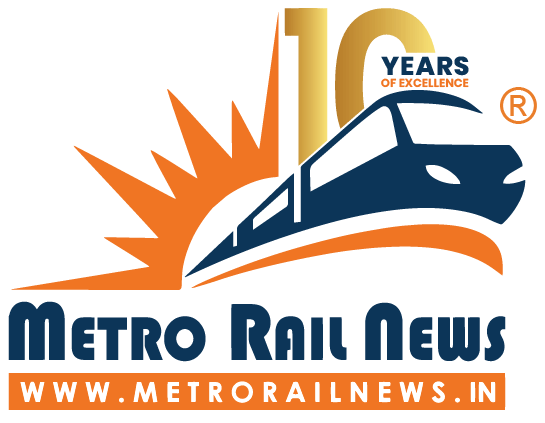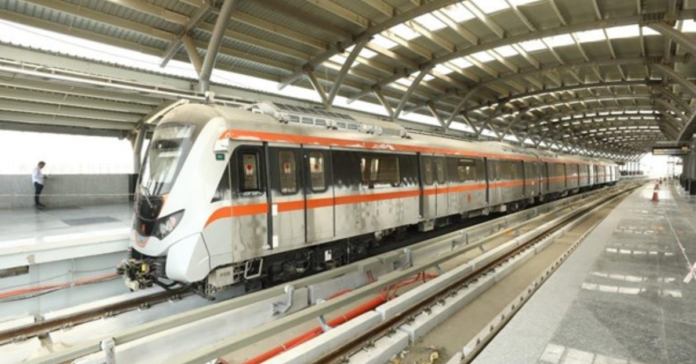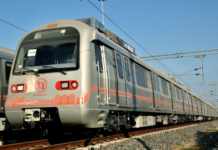Overview
Surat, India’s textile and diamond centre, is on its way to become the second city in Gujarat to be connected to a metro system. The metro system, scheduled to span over a distance of 41-kilometer aims to improve transportation infrastructure by connecting important regions and major commercial hubs. The Phase-I of the project is expected to be completed by December 2027.
The Surat Metro project was approved by the central government in March 2019. It is a joint venture between the Central and State governments, and it is managed by the Gujarat Metro Rail Corporation (GMRC). Surat Metro has been envisioned as a Transit-Oriented Development project to stimulate real estate expansion in the city through an integrated town and land use plan. The Delhi Metro Rail Corporation (DMRC) was given the responsibility for preparing the Detailed Project Report (DPR) for the first phase of the project in January 2016. However, in response to the Central Government’s new 2017 Metro Policy, the DPR was updated to include the most recent regulations.
Work on the redesigned Surat Metro rail project began in January 2021, with a segment anticipated to be completed in December 2024. Phase I is projected to be completed around December 2027. The project’s Phase-I investment is estimated to be over Rs 12,000 crore. It will consist of two corridors, the Red Line and the Green Line, totaling 41 km in length.
Line, Route & Corridor
Surat Metro includes 38 stations spread across two corridors. It consists of 32 elevated stations and six underground stations. The first corridor, the Red Line, is projected to be 21 kilometres long, with a 15-kilometre elevated part and a 6.5-kilometre underground section. It will connect Sarthana to Dream City, while the second corridor, the Green Line, will connect Bhestan to Saroli. Dream City and Bhestan will each have two maintenance depots, one for each route and corridor.

The Red Line will connect Sarthana, Nature Park, Kapodra, Labheshwar Chowk, Central Warehouse, Surat Railway Station, Maskati Hospital, Gandhi Baug, Majura Gate, Roopali Canal, and Dream City via twenty metro stations. There will be eighteen elevated stations along the second corridor. Bhestan, Ugat Vaarigruh, Palanpur Road, LP Savani School, Adajan Gam, Aquarium, Majuragate, Kamela Darwaza, Magob, and Saroli will be connected. The interchange station for the two corridors will be Majura Gate. Along the planned corridors, the metro is expected to be integrated with other modes of travel, such as feeder buses, intermediate transport (IPT), and non-motorised transport (NMT).
Infrastructure
Surat Metro will have a 1,435 mm standard gauge track for both corridors, with a top speed of 80km/h and a designed and approximate speed of 90km/h. The ticketing system will include an autonomous fare collection system, which will consist of a computerized contactless smart token for a single travel and contactless smart cards for multiple trips along the route.
It will include a fibre optic cable, train radio, supervisory control and data acquisition (SCADA), and a public address system as part of an integrated telecommunication system. The signalling system will include cab signalling and an automatic train operation system, as well as continuous automatic train control. To improve operating safety, automatic train supervision equipment will be deployed.
Rolling stock & maintenance facilities
According to the DPR, trainsets with stainless steel car bodies are being considered for the metro project. The preferred layout is three-car trains, with each train carrying around 764 passengers, 136 seated and 628 standing. Train-based monitor and control systems, such as train control and management systems or train-integrated management systems, will be deployed on the trains. The trains will have a maximum and top operating speed of 80km/h. In the first phase, two maintenance depots have been planned to be built, one in each corridor at Dream City and Bhesan. Solar energy will be harnessed through the installation of solar equipment at the depots.
Financing
The project has been designed to be funded primarily by 50:50 equity contributions by the central and state governments. A portion of the funding will be acquired through loans from bilateral and international institutions. For the project, the federal government signed a credit agreement of $500.13 million with Kreditanstalt für Wiederaufbau Development Bank in December 2021. A funding agreement totalling $303.16 million was signed in January 2021 between the Indian government and the French Development Agency, Agence Française de Développement, for the metro project.
Major Contractors involved
Under a Rs 6.73 billion contract awarded in April 2023, Rail Vikas Nigam, a special purpose vehicle involved in development projects, would deliver and commission a power supply receiving and distribution system for phase one of the project in collaboration with technology company Siemens.
HFCL, a manufacturer of optical fibre and optical cables, was given a Rs 2.82 billion contract in March 2023 for the design, supply & procurement, installation, and commissioning of telecommunication systems for phase one of the project. In January 2023, GMRC signed a letter of acceptance with the Rail Vikas Nigam – ISC Projects JV for the design, delivery, installation, and commissioning of ballastless track from Sarthana to Dream City under a Rs1.66 billion deal. For corridor one, the JV will also provide ballasted/ballastless/embedded standard gauge track.
Dilip Buildcon, a construction company, was granted a contract for the project’s package CS-06 in July 2022. The plan involves the building of an 8.702 km elevated bridge and seven stations between Majura Gate and Saroli. Dilip Buildcon, in collaboration with Ranjit Buildcon, was also granted the contract for Package CS-05, which entails the building of a 10.559 km elevated viaduct and corridor.
In 2020, Ardanuy Ingenieria and engineering consultancy Rail India Technical and Economic Service (RITES) were appointed to provide detailed design consultation services for the power supply and distribution system, 750V DC third rail traction electrification, and SCADA system. Again in 2020, a consortium of RITES and Rina Consulting, a provider of engineering and consultancy services, was hired to provide consulting services for the creation of a multi-modal integration plan for both corridors. RITES also developed the environmental impact assessment and social effect assessment documentation for Surat Metro Phase One.
Rina Consulting was also granted the contract in 2021 to deliver detailed-design consultancy services for environment simulation studies and tunnel ventilation system of phase one’s underground portion. In August 2021, consulting and engineering firm SYSTRA was awarded a contract to conduct a DPR review and design review, as well as procurement support and construction supervision for civil and system works in collaboration with joint venture (JV) partners EGIS Rail, a consulting and construction engineering services provider, and consulting firm AECOM.
The contract also includes system integration, project management, and other services such as safety and quality inspection, testing, and commissioning. The JV’s lead partner is SYSTRA, and J Kumar Infraprojects, a civil engineering firm, was awarded the package for the building of the underground portion between the Surat railway station and the Chowk Bazar ramp. The contractual scope covers the design, building, and completion of underground stations and tunnels. A twin-bore underground tunnel is being built, as there are three underground stations: Chowk Bazar, Maskati Hospital, and Surat Railway Station.
Sadbhav Engineering and SP Singla Constructions’ joint venture was given a contract to build an 11.6 km-long elevated viaduct between Kadarsha Ni Nal and Dream City, including a ramp for depot access near Dream City and 10 stations. Gulermak-SAM India Builtwell JV was awarded the contract for the design, building, and completion of underground stations and tunnels between the Kapodra ramp and the Surat railway station.
A tender for the development and construction of the Dream City depot, Metro Bhavan building, and operations control centre in June 2021 was given to ITD Cementation India, a construction company. TERRATEC, a tunnel boring machine (TBM) designer and manufacturer based in Australia, was contracted to deliver earth pressure balance TBMs for phase one of the Surat Metro rail project. The orders for all four Earth Pressure Balance Tunnel Boring Machines (EPB TBMs) for the rail project have been acquired. EPB TBMs, both new and refurbished, are expected to be deployed for the project.
Key Specifications & Details
- Operational : 0 Km
- Under Construction: 41.93 Km
- Approved : 0 Km
- Estimated Cost: Rs. 12,020.32 crore
- Estimated Daily Ridership: 2.20 Lakh/Day (2027)
- Top Speed: 80 Kmph
- Average Speed: 34 Kmph
- Track Gauge: Standard Gauge (1435mm)
- Electrification: 750 V DC Third Rail
- Signalling: Communication-based train control (CBTC)
Latest Update
Surat Metro is being built across 2,000 acres of land near Khajod to improve accessibility and make the area more appealing for commercial development. According to the latest reports, the Gujarat Metro Rail Corporation (GMRC) has awarded HCFL a Rs 282 crore contract for the design, manufacture, supply, installation, testing, and commissioning of telecommunication equipment for the Surat Metro Rail Project Phase-I. This North-South road will link Varachha, where the majority of diamond workshops are located, to the Dream City area. It will also connect to the Surat International Airport. Surat Metro’s fare structure, travel time, and other operational features, on the other hand, remain to be disclosed. The integrated mass public transportation system is projected to reduce accidents, traffic congestion, and delays on important travel corridors, as well as pollution and energy consumption. It has also been predicted to minimise and offset 40,000 tonnes of CO2 emissions.
The GoI approved the under-construction mass rapid transit system in Gujarat in March 2019. Gujarat Metro Rail Corporation (GMRC), a special-purpose vehicle jointly controlled by the governments of India and Gujarat, is in charge of project implementation. In January 2016, the Delhi Metro Rail Corporation was awarded the contract to develop the detailed project report (DPR) for the first phase of the Surat Metro. DMRC later reviewed and modified the DPR to include additional provisions in accordance with the new Metro Rail policy – 2017 by the central government. The foundation stone for the project was laid in January 2021, with projected completion of the works by 2027. The project is expected to cost around Rs 120.2bn. 40.35 kilometres long first phase of Surat Metro has been planned to include thirty-eight stations spread across two routes. The plan features thirty-two elevated and six underground stations. The first corridor is projected to be 21.61 kilometres long, with a 15.14-kilometre elevated segment and a 6.47-kilometre underground section. It will connect Sarthana and Dream City, while the 18.74-kilometre-long, completely elevated second corridor will connect Bhesan and Saroli. The corridors will link the most congested, significant, and densely populated parts of the city.






